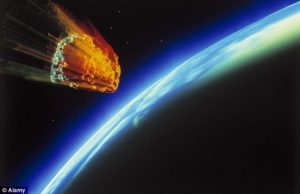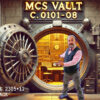Mandeville, LA – Exclusive Transcript – My point is, we incessantly worry about some of these silly environmental concerns that we have no control over whatsoever, yet we live within the grace of God that we don’t get hit by an asteroid. We live within a couple seconds of astrological history changing, the entire human species, hell almost all species, being wiped out. That’s why I bring this up. What happens if the scientists are wrong? Check out today’s transcript for the rest…
This page is supported by your Founders Pass Subscriptions, please take our membership tour & consider a 1 year membership
Begin Mike Church Show Transcript
Mike: This asteroid that we talked about the other day, do you remember this?
AG: Yep.
Mike: It has a name. It is DA14. Of course, I view the name DA14 and I just think to myself: Somebody named the asteroid Dumbass 14? I know what the D and A stand for, but I thought that was funny. We have been assured by our scientific overlords — those are the people at NASA who, again, have never been incorrect ever. They’re always right. The first rovers they sent to Mars worked without a hitch. They’re the ones that disappeared in the Martian atmosphere that we still don’t know what happened to. All the calculations that NASA has ever made are always infallible. They are 100 percent correct.
So we have this asteroid that’s going to pass by here on Friday. Ladies and gentlemen, I don’t know if you realize this, but we live in a very caustic environment. In the little blip of history that we occupy, say 8,000 years of written history or so, there aren’t very many cataclysmic astrological events that have changed the course of mankind. There was the giant asteroid that hit in Tunguska, Russia in 1908. It actually incinerated just before making an impact. That’s how hot it got entering the Earth’s atmosphere. It was about the size of DA14, if you follow these sorts of things, and it obliterated 835 square miles of forestland. If you look at that part of Russia from a satellite, you can still see the blast radius. From space, you can physically see with your eyes where that asteroid hit.
If that rock had been 2,000 miles to the west — I’m paraphrasing and guesstimating the mileage. Had it been 2,000 miles to the west, it would have incinerated over what we call today the United Kingdom. It would have wiped out all life, all of it. There would have been nothing left. It would have obliterated every living thing within 835 square miles, which would have been the entire United Kingdom and parts of Scandinavia. It just would have been wiped out. Just consider that for a moment.
Let’s say it were to hit the United States. It would basically wipe out — let’s say it hit right in the middle in Kansas. It would destroy everything in Kansas and the surrounding five or six states, depending on how far that 835 square miles stretches out. That is quite a — I may be exaggerating just a bit — footprint. It’s not even a football field long. Imagine what happens if one that’s twice that large, and there is one out there that’s twice as large that’s supposed to pass by in 2036. Imagine if that one, if the calculations from the geniuses in the astrological world are incorrect.
My point is, we incessantly worry about some of these silly environmental concerns that we have no control over whatsoever, yet we live within the grace of God that we don’t get hit by an asteroid. We live within a couple seconds of astrological history changing, the entire human species, hell almost all species, being wiped out. That’s why I bring this up. What happens if the scientists are wrong? There’s a video on the BBC website that accompanies “’Record-close’ asteroid may miss the Earth but it could take out your phone.” Andrew, have you seen this? I watched this last night and I watched it in horror. Have you seen the video?
AG: No. I saw it said it could take out some satellites but even that’s pretty remote.
Mike: You have to watch the actual animation to see how it would take the satellites out. What the damn thing is going to do — it’s hard to grasp this with me telling the story audibly. It’s a lot easier to get it to just watch the video. So what’s basically going to happen — I just want to try to explain this as best I can. Just imagine that the geosynchronous orbiting satellite — here’s from the BBC video. This will briefly explain it. I just think this is fascinating.
[start audio clip]
Don Yeomans: Asteroid 2012 DA14 is an object about half the size of a football field in diameter that is going to pass very close to the Earth on February 15th. Coming from the south to the north, it actually gets to within 17,200 miles of the Earth’s surface and will pass interior to the geosynchronous satellites and the GPS satellites, but there’s really no chance of the asteroid hitting the Earth and very little chance it will hit a satellite. [Mike: Comforting, huh?]
Although this object gets very close to the Earth on February 15th, it’s fairly small as asteroids go. It won’t be observable with the naked eye. If you happen to be located in eastern Europe, Asia, Australia, and you know where to look and you have a pair of binoculars, it will indeed be visible. The asteroid was discovered by a group of Spanish astronomers in the La Sagra Observatory in southern Spain.
An object the size of DA14 actually impacted the Earth on June 30th, 1908, the so-called Tunguska event. An object of about 30 or 40 meters came down into the Earth’s atmosphere and exploded, leveling trees for 820 square miles. The close approach of this object 2012 DA14 on February 15th is nothing to worry about. Its orbit is very well known. We know exactly where it’s going to go and it cannot hit the Earth. [Mike: Don Yeomans is a NASA physicist.]
Twenty years ago, we probably wouldn’t have found this object, but now NASA is observing the skies nightly and picking up these objects and can track them 100 years into the future and see if any of them make interesting close-Earth approaches, not only because of a threat issue but because these objects are important for science. They’re important for future researchers…
[end audio clip]
Mike: The reason I wanted to play that, the geosynchronous or geostationary satellites orbit at 22,300 miles above the Earth, somewhere on that order. What that means is they’re far enough out that there’s just enough gravity to hold them into position but not enough, in the short run anyway, to suck them down so they’ll crash into the Earth, thus geostationary. That’s how far out you have to go to put a satellite in the air so that it stays put and doesn’t tend to want to be pulled in by the Earth’s gravity and want to crash. Just imagine 22,000 miles straight up from where you currently are, Mr. Gruss, 22,000 miles straight up in the air is a band. There are satellites up there that you can’t see, like the Sirius XM satellite. That’s probably where they are. I’m assuming we have geostationary satellites, although I know the Sirius satellites orbit in a figure-eight constellation. I’m not exactly sure how that works. Scratch that just for a moment.
You have a band of manmade objects that have been launched by man into space and are now sitting up there 22,000 miles above the Earth’s surface. Think about this for a minute. That asteroid is going to cross that band of 17,000, the south part of the planet. It’s going to be pulled in by the Earth’s gravity. It is then going to stay inside that band. In other words, it’s going to be hurtling above the Earth, not hitting it — according to the scientists anyways — at 5,000 miles inside the band. It’s compromised the band of where the geosynchronous satellites are. Then, as it gets to the northern part of the Earth, inertia will kick in and Newton’s physics will kick in and it will escape our gravitational pull. It will then go back through the 22,000-mile band of where the satellites are. It is a chance that it could whack one of those satellites when it goes through the first time and when it exits.
Just think about that for just a moment. That’s how close vast swaths of humanity can be from being wiped out in a nanosecond, just bam. What if we didn’t have satellites and had no ability to track this thing whatsoever, if you didn’t know that DA14 was coming, no one knew that it was coming? You just looked up one Friday evening and saw it whiz above your head: Hey, what’s that? Ponder that for a moment and ponder then the scale of our miniscule existence. I think that should put things a little more clearly in perspective when it comes to the fallibility and utter futility of mankind and the universe. We think we can harness it and control it. We think we’re masters of it because we had Einstein or all these physicists and scientists and geniuses. They taught us how to harness atoms. They taught us how to split atoms. We can do anything we want with atoms. We can do anything we want with computers. We can do anything we want with electronics and electrons and protons. We’re masters of the universe.
Wait a minute, there’s a rock. Folks, seriously, ponder your existence here for just a moment. There’s a rock. It doesn’t have a computer. It doesn’t have propulsion. It doesn’t have a brain. It doesn’t have any thought process. It’s just a slab of granite or whatever it’s made out of, cobalt, and it has the potential to significantly alter the course of tens if not hundreds of millions of people’s lives if it is half a degree off one way or the other as it traverses and travels throughout the solar system. Put that in your “there is no transcendent and there is no higher force at work here” pipe and smoke it.
End Mike Church Show Transcript


















Post comments (0)